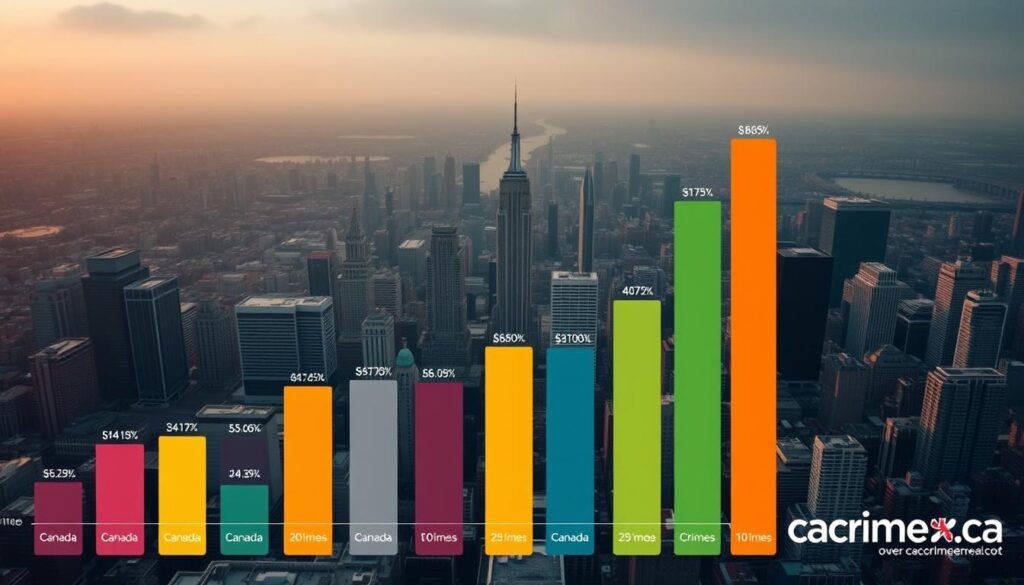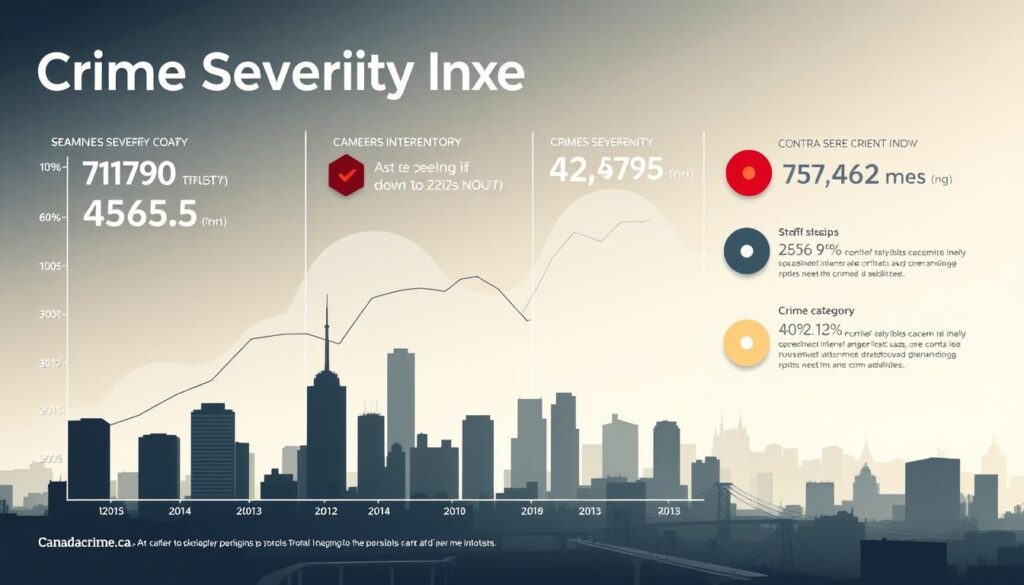In 2023, crime statistics revealed that Nova Scotia’s crime rate stood at 5,933.2 incidents per 100,000 population, surpassing Canada’s national average of 5,843.1 per 100,000 population. This marks the third consecutive year that Nova Scotia’s crime rate has exceeded the national average, raising concerns about crime severity and its impact on communities.
The trend is noteworthy, especially when considering historical data. According to a report, the official police-reported crime rate in Nova Scotia has more than quadrupled since 1962, indicating a significant shift in crime patterns over the decades.
Understanding the nuances of crime rates, including the differences between violent and property crimes, is crucial for developing effective crime prevention strategies. This article aims to provide a comprehensive analysis of Nova Scotia’s crime rate in the context of broader Canadian crime statistics.
Current State of Nova Scotia Crime Rate
In 2023, Nova Scotia witnessed a slight decrease in its crime rate, a notable exception in the Canadian crime statistics landscape. This change is particularly significant when compared to the national trend, where the overall crime rate increased. Understanding the nuances of Nova Scotia’s crime statistics provides valuable insights into the province’s safety and security.
Overview of 2023 Crime Statistics
Nova Scotia’s crime rate decreased by 0.5% in 2023, reporting 5,933.2 criminal code violations per 100,000 residents. This rate, although higher than the national average of 5,843.1 per 100,000 population, indicates a divergence from the national trend of increasing crime rates. The province’s largest urban center, Halifax, experienced a 1.5% decrease in crime rate, with 5,665.5 incidents per 100,000 population.
The data reveals that while Nova Scotia’s overall crime rate decreased, there was a 1.1% increase in violent crime from 2022 to 2023. Conversely, property crime rates declined by 1.3% during the same period, with Halifax seeing an even larger decrease of 3.6%. These statistics highlight the complex nature of crime trends in the province.
- The overall crime rate in Nova Scotia decreased by 0.5% in 2023.
- Halifax experienced a 1.5% decrease in its crime rate.
- Violent crime increased by 1.1% from 2022 to 2023.
- Property crime rates declined by 1.3% across Nova Scotia.
Comparison with National Averages
Nova Scotia was one of only three provinces, along with Manitoba and Alberta, to see a decrease in crime rates in 2023. Nationally, Canada’s crime rate increased by 2.5%, with the largest increase reported in Prince Edward Island. The crime severity index, which measures the seriousness of crimes, provides further insight into the nature of criminal activity in Nova Scotia.

The comparison between Nova Scotia’s crime statistics and national averages underscores the province’s unique position in the Canadian crime landscape. While the national crime rate rose, Nova Scotia’s decrease suggests effective crime prevention strategies or other factors contributing to this trend.
Types of Criminal Code Violations in Nova Scotia
To grasp the full picture of crime in Nova Scotia, it’s essential to examine the different types of criminal code violations. The province experiences a range of criminal activities, from violent crimes to property violations and other offenses.
Violent Crime Statistics
Nova Scotia reported 1,612.1 violent Criminal Code violations per 100,000 residents in 2023, exceeding the national average of 1,427.9 violations per 100,000 residents. Violent crimes include homicide, assault, sexual assault, and robbery. Halifax, the province’s capital, had a violent crime rate of 1,464.6 incidents per 100,000 residents.
- Homicide rates have seen fluctuations, contributing to the overall violent crime rate.
- Assault and sexual assault are significant components of violent crimes.
- Robbery also contributes to the violent crime statistics.

Property Crime Trends
In 2023, Nova Scotia recorded 3,380.2 property violations per 100,000 residents. Property crimes include break and enter, theft, fraud, and mischief. While this rate is slightly lower than the national average of 3,391.6, it indicates a significant portion of criminal activity in the province.
- Break and enter incidents are a concern, often linked to other property crimes.
- Theft remains one of the most common property crimes.
- Fraud and mischief also contribute to the overall property crime rate.
Other Criminal Code Violations
Other Criminal Code violations, including disturbing the peace and offenses against the administration of justice, accounted for 940.9 incidents per 100,000 residents. These crimes, while not directly violent or property-related, still impact the overall crime rate and public perception of safety.
The trends in these categories have been influenced by changes in police reporting practices, particularly since the 2018 change in the definition of “founded” criminal incidents.
Regional Crime Comparisons Across Canada
Regional crime comparisons across Canada reveal a complex picture, with some provinces and cities experiencing higher crime rates than others. Understanding these variations is essential for contextualizing Nova Scotia’s crime statistics within the national landscape.
Crime Rate Rankings Across Provinces
Provincial crime rate rankings show that Manitoba and Saskatchewan consistently report the highest crime rates in Canada, while Quebec and Ontario maintain the lowest rates per 100,000 residents. Notably, Prince Edward Island experienced the largest increase in crime rate in 2023, despite historically having lower crime rates than many other provinces. This shift highlights the dynamic nature of crime statistics and the need for ongoing analysis.
The crime rates in Prince Edward Island, New Brunswick, and Nova Scotia are particularly relevant when examining regional trends in Atlantic Canada. While Nova Scotia’s crime rate is a concern, it is essential to compare it with neighboring provinces to understand the broader context.
Urban vs. Rural Crime Patterns
Urban versus rural crime patterns reveal significant variations, with data showing that areas outside major cities in Manitoba and Saskatchewan account for much of these provinces’ high crime rates. In contrast, cities like Toronto, Montreal, and Vancouver tend to have lower crime rates compared to their rural counterparts. The crime rate in Halifax, Nova Scotia’s capital, is an important data point for understanding urban crime patterns in the region.

Halifax Crime Statistics
Halifax crime statistics provide a detailed look at the city’s crime rate, which stands at 5,665.5 incidents per 100,000 population. Comparing Halifax to other Atlantic Canadian cities like Moncton, which reported higher crime rates, and Saint John, which reported lower rates, offers valuable insights into regional crime trends. Additionally, comparing Halifax to major urban centers across Canada, such as Toronto and Vancouver, helps to contextualize its crime rate within the national landscape.
The analysis of crime statistics across different regions highlights the importance of considering various factors, including socioeconomic conditions, population density, and policing resources, when comparing crime rates. Furthermore, differences in policing practices and reporting methods across jurisdictions can affect the comparability of crime statistics, underscoring the need for careful analysis.
Crime Severity and Specialized Categories
The Crime Severity Index and specialized crime categories offer valuable insights into the nature and severity of crimes committed in Nova Scotia, providing a more detailed picture than overall crime rates alone. This nuanced understanding is crucial for developing effective crime prevention strategies and policies.
Understanding the Crime Severity Index
The Crime Severity Index (CSI) is a weighted measure that takes into account both the volume and the seriousness of crimes, offering a more comprehensive view than simple crime rates. Nova Scotia’s Total Crime Severity Index was 73.8, compared to the national average of 80.5. This indicates that while crimes are being committed, their overall severity is lower than the national average.
The CSI is calculated using weighted clearance rates and sentencing data to reflect the relative harm of different offenses. This approach allows for a more accurate comparison of crime severity across different regions.
Youth Crime in Nova Scotia
Youth crime in Nova Scotia presents concerning trends, with a rate of 3,048.3 violations per 100,000 residents aged 12-17, exceeding the national youth crime rate of 2,898.1. This represents a 16.1% increase in youth crime in Nova Scotia in 2023, with a dramatic 40.3% rise in Halifax.
Understanding the factors contributing to this trend is crucial for developing targeted interventions. Potential factors may include socioeconomic conditions, community resources, and the effectiveness of youth justice programs.
Drug and Traffic Violations
Nova Scotia reported 378.1 Criminal Code traffic violations and 92.9 drug violations per 100,000 residents in 2023. While the drug violation rate was below the national average of 113.6 per 100,000 residents, recent trends show a 12.0% increase in Nova Scotia and a 22.3% increase in Halifax.
Recent Trends in Drug Offenses
Recent trends in drug offenses indicate a shift in drug-related activities, with Nova Scotia and Halifax experiencing increases contrary to the national trend. Factors influencing these trends may include changes in drug laws, enforcement priorities, and social factors.
Despite the recent increases, drug crime rates remain substantially lower than they were prior to 2018. Understanding these trends is essential for policymakers and law enforcement agencies to adjust their strategies effectively.
| Category | Nova Scotia Rate | National Average Rate |
|---|---|---|
| Total Crime Severity Index | 73.8 | 80.5 |
| Youth Crime Rate | 3,048.3 | 2,898.1 |
| Drug Violations | 92.9 | 113.6 |

Crime Prevention Strategies in Canada
Crime prevention in Canada, particularly in Nova Scotia, requires a multifaceted approach that addresses the root causes of criminal activity. Community-based prevention programs are being implemented to target issues such as poverty, substance abuse, and lack of educational and employment opportunities.
Law enforcement agencies in Nova Scotia are utilizing crime statistics and the Crime Severity Index to allocate resources more effectively and develop targeted prevention strategies. For instance, the violent crime rate analysis helps in understanding the trend and pattern of crimes, enabling proactive measures.
Youth crime prevention is receiving special attention due to the concerning 16.1% increase in youth crime in Nova Scotia in 2023. School-based programs, mentoring initiatives, and diversion programs are being explored to address this issue.
Technological innovations, including data analytics to identify crime hotspots, are also being employed. Furthermore, rehabilitation and reintegration programs for offenders are crucial in reducing recidivism rates.
A collaborative approach involving multiple stakeholders, including police, social services, and community organizations, is essential in addressing complex crime issues. By adopting evidence-based approaches and continuously evaluating prevention strategies, Nova Scotia can effectively address its specific crime challenges.

